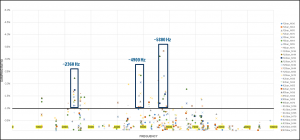Brake System Engineering Helps with Brake Squeal
As braking conditions differ across a number of different situations, brake squeal analysis has to be carried out under a variety of conditions, such as varying fluid pressures, coefficient of friction, and disc velocity. There are multiple simulation scenarios which need to be carried out and which may result in significant solution times. To minimize the solution time, a standard practice is to complete the first part of the simulation which includes applying pretension loads on the bolts and pressure on the pistons. One can then perform a restart analysis to complete the subsequent scenarios and resultant eigenfrequency steps (across different rotation speeds, coefficients of friction, and pressures). The Process Composer app on the 3DEXPERIENCE platform lets one automate these simulations. The user just has to run the process, which will subsequently take care of running all simulations in parallel.

Once all of the simulations are completed, frequency vs. damping ratio results are plotted. For such “instability analysis,” a negative damping ratio is an indicator of unstable modes, and a primary variable is identifying and understanding these unstable modes. A high (in absolute value) negative damping ratio denotes a high likelihood of instability in the system. These frequencies at which multiple negative damping value data points are present across multiple scenarios are frequencies of high likelihood for brake squeal. Further mode shapes can be studied to understand the system behavior at those frequencies. Referring to the image below, rectangular boxes (2360 Hz, 4900 Hz and 5800 Hz) highlight the brake squeal frequencies.

So back to the main question: How does one get rid of those frequencies/higher damping ratios? This is not always straight forward. There are many factors that impact brake system instability. Brake disc stiffness, coefficient of friction, stiffness of the backing plate, and piston pressure are just a few.
Using the same process composer template, one can add parameters for Young’s modulus of backing plate (to represent material changes), rotor disc, thickness of rotor disc, etc. and repeat the brake squeal analysis and arrive at more robust designs with minimized brake squeal propensity.
Based on this example study shown above, one can arrive at the following observations:
- Coefficient of friction: Higher COF between the brake pad and rotor disc increases friction induced instability in the system and thus brake squeal propensity increases. (This observation is well-known to anybody who is already familiar with this subject). One can reduce friction coefficient to reduce brake squeal but this of course will reduce the braking performance hence it is generally not preferred.
- Stiffness of rotor disc: Stiffness of rotor disc can be increased either by increasing thickness and/or by choosing a higher Young’s modulus material. We changed the thickness of the rotor disc (since the rotor disc CAD model was parametric, it took just few minutes to change it). The results showed that the negative damping ratio (absolute value) decreased significantly indicating diminished instability in the system. So higher disc stiffness helps in reducing brake squeal, an observation which is again consistent with expectations.
- Backing plate stiffness: Since the brake pad material attached to the backing plate is relatively soft, increasing backing plate stiffness increases uneven deformation and magnitude of vibrations in the brake pads. This results into an increase in the negative damping ratio. Hence Young’s modulus of backing plate was reduced, which resulted in decreasing the negative damping ratio – this leads to a brake system with a lower brake squeal propensity, but may have other performance consequences.

For this study, we increased the rotor disc stiffness and reduced the backing plate stiffness. This helped us to reduce the brake squeal propensity at 4900 Hz and 5800 Hz. In many automotive environments, modification to the disc design may not be possible. But this same approach could instead be used to explore changes to caliper, brake knuckle, or even brake pad designs which could similarly reduce brake squeal, often without compromising other key performance attributes.

Thanks to the 3DEXPERIENCE Platform, I was able to design silent brakes for my car and provide a nice, peaceful sleep for my child!
See our brake simulation solutions by visiting: https://www.3ds.com/products-services/simulia/solutions/transportation-mobility/brake-system-engineering/
SIMULIA offers an advanced simulation product portfolio, including Abaqus, Isight, fe-safe, Tosca, Simpoe-Mold, SIMPACK, CST Studio Suite, XFlow, PowerFLOW and more. The SIMULIA Learning Community is the place to find the latest resources for SIMULIA software and to collaborate with other users. The key that unlocks the door of innovative thinking and knowledge building, the SIMULIA Learning Community provides you with the tools you need to expand your knowledge, whenever and wherever.

